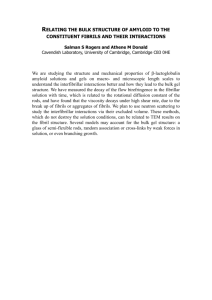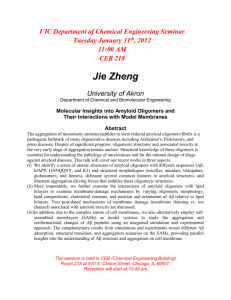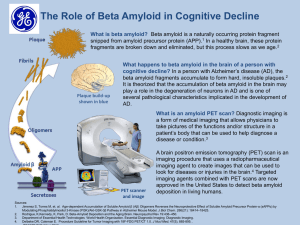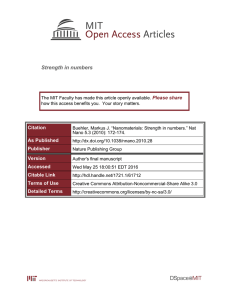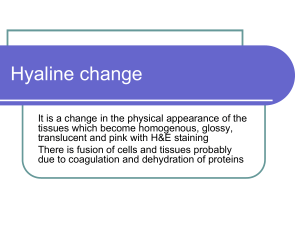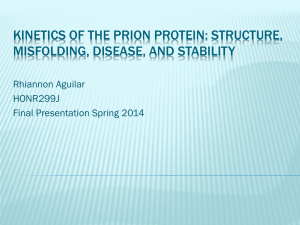Suppl_2012-07-11_Kwon
advertisement
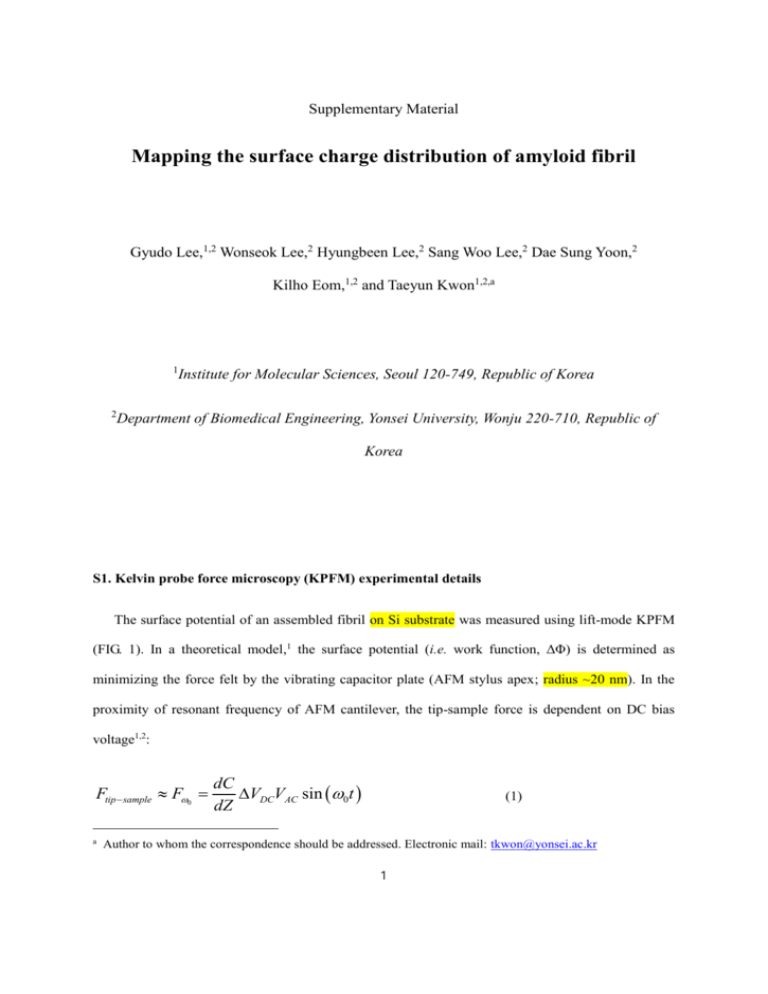
Supplementary Material Mapping the surface charge distribution of amyloid fibril Gyudo Lee,1,2 Wonseok Lee,2 Hyungbeen Lee,2 Sang Woo Lee,2 Dae Sung Yoon,2 Kilho Eom,1,2 and Taeyun Kwon1,2,a 1 2 Institute for Molecular Sciences, Seoul 120-749, Republic of Korea Department of Biomedical Engineering, Yonsei University, Wonju 220-710, Republic of Korea S1. Kelvin probe force microscopy (KPFM) experimental details The surface potential of an assembled fibril on Si substrate was measured using lift-mode KPFM (FIG. 1). In a theoretical model,1 the surface potential (i.e. work function, ΔΦ) is determined as minimizing the force felt by the vibrating capacitor plate (AFM stylus apex; radius ~20 nm). In the proximity of resonant frequency of AFM cantilever, the tip-sample force is dependent on DC bias voltage1,2: Ftip sample F0 a dC VDCVAC sin 0t dZ (1) Author to whom the correspondence should be addressed. Electronic mail: tkwon@yonsei.ac.kr 1 where C is capacitance, Z is distance, ΔVDC and VAC are the D.C. and A.C. voltage between AFM tip apex and sample surface, and ω0 is the resonant frequency of the conductive cantilever (SCM-PIT, Veeco). Here, an applied D.C. voltage (VDC,App) is adjusted until the cantilever amplitude should be zero (Fω0 = 0), VDC VDC , App sample (2) All KPFM imaging is performed using a same conductive AFM cantilever (ω0 = 57.3 kHz) under identical condition such as tip bias voltage (VDC,App) of +4 V, scan rate of 0.5 Hz, and lift height of 5 nm, respectively. In KPFM experiment, the tip-sample distance (Z) is critical because the measured surface charge (σ) is almost obeyed to coulomb’s law (σ ∝ Z-2).3,4 For imaging the surface potential of amyloid fibrils (whose diameter is given as d ~ 1.2 - 3.3 nm), the lift height of 5 nm is very sufficient to sensitively detect the surface charge of amyloid fibril. S2. UV-vis-absorbance data Fig. S2 shows the UV-vis absorbance spectra of filtered supernatant of β-lactoglobulin solution as well as heated supernatant, respectively. A maximum absorbance for supernatant was recorded at wavelength of 278 nm, while a maximum absorbance of heated supernatant was observed at wavelength of 290 nm, which is consistent with the result of previous studies.5,6 S3. pH-dependent surface potential distribution of amyloid oligomer The β-lactoglobulin amyloid fibrils and oligomers prepared in buffer solution solution (1 wt%) at pH 2 were diluted into another solution (0.02 wt%, pH 3-7) in order to measure the pH-dependent surface charge distribution of amyloid fibrils. The surface charge distribution of β-lactoglobulin 2 amyloid oligomers is shown in Fig. S3. Fig. S1. Transmission election microscope (JEM-2100F, JEOL, Japan) image of βlactoglobulin amyloid protofilaments and oligomers. The scale bar is 500 nm. 3 Fig. S2. Absorbance spectra of the supernatant of filtered β-lactoglobulin (without heating) and heated supernatant, respectively. 4 Fig. S3. Surface charge distribution of β-lactoglobulin oligomers adjusted at different pH solution to determine pI value, which is compared with that of β-lactoglobulin fibrils (Fig. 4). A relationship between surface charge distribution and pH is fitted to Boltzmann sigmoidal curve to determine isoelectric point (pIoligomer ~ 4.7). 5 References 1 M. Nonnenmacher, M. P. O'Boyle, and H. K. Wickramasinghe, Appl. Phys. Lett. 58, 2921 (1991). 2 3 A. K. Sinensky and A. M. Belcher, Nat. Nanotechnol. 2, 653 (2007). J. Park, J. Yang, G. Lee, C. Y. Lee, S. Na, S. W. Lee, S. Haam, Y.-M. Huh, D. S. Yoon, K. Eom, and T. Kwon, ACS Nano 5, 6981 (2011). 4 5 P. Zhang and H. F. Cantiello, Appl. Phys. Lett. 95, 033701 (2009). L. N. Arnaudov, R. de Vries, H. Ippel, and C. P. M. van Mierlo, Biomacromolecules 4, 1614 (2003). 6 N. Poklar, G. Vesnaver, and S. Lapanje, Biophys. Chem. 47, 143 (1993). 6
